
• Introduction
• 1 Writing Sanskrit
• 2 The Alphabet
• 3 The Birthplaces of Sanskrit Sounds
• 4 Introducing the Vowels
• 5 Simple Vowels
• 6 The Vowel Ṛ
• 7 Diphthong Vowels
• 8 Vowel Duration & Syllable Duration
Introduction
The purpose of this course is to help aspirants learn correct pronunciation of Sanskrit, with particular focus on reciting mantras with ease and confidence. With time and practice, the phonetic perfection of Sanskrit will reveal itself. The exercises contained within this manual are designed to facilitate discovery of the perfect form of articulation within the mouth so that the Sanskrit sounds and mantras come to life, taking shape within the various meters of verse. This is the study of śikṣā and uccāraṇa.
Śikṣā (from the root śikṣ meaning to impart) refers to the transmission of a mantra’s potency from guru to disciple, planting the seeds of perfect pronunciation, understanding and intention. uccāraṇa (from ut, meaning uplifting, and caraṇa, meaning with movement) refers to the applied effort of the disciple in nurturing that seed into a sturdy tree that produces spiritual fruits. In this way, the fruits of Sanskrit propagate from generation to generation through the oral tradition, preserving the majesty of thought discovered by the Vedic culture so long ago.
The Nature of Sanskrit
Sanskrit is the ancient, classical sacerdotal language of India, treasured as a pure vehicle for communication with the celestial worlds. It is the primary language in which Hindu scriptures, including the Vedas and Agamas, are written. Also in Sanskrit are Jain and Buddhist scriptures and thousands of ancient scientific and literary works. One of India’s 22 official languages, it is employed today as a liturgical, literary and scholarly language, but is no longer a widely spoken vernacular.
Sanskrit (Saṃskṛta) is composed of two words: samyak and kṛta. Samyak means together. Kṛta means performed or done. Saṃskṛta carries the meaning of action with integrity of thought, word, and deed that are “refined,” “perfected” and “sanctified.” The origins of Sanskrit are rooted in the oral tradition of the Vedic culture. In ancient times, adepts from this culture immersed themselves in deep meditation. From that state of deep stillness, they discovered that everything in existence is vibrating. They intuited the signature vibrations of the natural world: the rocks, the trees, the rivers, etc. Through their deep listening, the adepts constructed a garland of syllables that make up the Sanskrit alphabet, or akṣaramālā. The adepts used this indestructible (akṣara) garland (mālā) of syllables to make words, then strung words together into inspired poetry conveying their experiences of inner illumination.
The study and expression of Sanskrit is the subject of four of the six limbs, or ancillary texts, of the Vedas, called Vedāṅgas. These four limbs are: 1) Śikṣā (phonetics, pronunciation), 2) Vyākaraṇa (grammar), 3) Chandas (meter) and 4) Nirukta (etymology).
Later, in the post-Vedic period, Pāṇini refined the grammatical conventions of Sanskrit with his treatise entitled Aṣṭādhyāyī.
To this day, the syllables of Sanskrit continue to carry the spiritual inheritance of ancient Vedic wisdom. Correct pronunciation of these syllables calls forth that inheritance and gives voice to the eternal nature of the soul.
As a language steeped in the intuitive awareness of the nature of existence, Sanskrit is a tool for inner discovery. Through the study and use of these syllables, it is said that the mind and body grow attuned to the vibrational frequency of the ancient yogis.
Because of this, Sanskrit is uniquely equipped to attune the mind to that state of deep stillness where communication leads to communion. The Sanskrit alphabet alone is a journey through the evolution of creation. Each point of articulation brings the body and mind into a coherency of vibration that guides the speaker into the source of creation. Learning proper pronunciation facilitates the journey from audible sounds, through the subtler vibrations of thought and feeling, into the source of all sound and vibration, the primordial Ōṃ.
Supplementary Video: An Introduction to Sanskrit
Lesson 1: Writing Sanskrit
Sanskrit is written in Devanāgarī, which is an alpha-syllabary script. It is important to keep this in mind when using the term letters, as Devanāgarī is not a simple alphabetic script like English.
In a fully syllable-based writing system there are no distinct letters, but rather characters representing entire syllables. For instance, observe the Japanese characters for ka か ke け and ko こ. There are no specific markings in these characters to show that each one contains the k sound. Devanāgarī characters, on the other hand, have clear glyphs for each base sound.
For example, the unadorned letter क is transliterated (and pronounced) ka, because the a sound is inherent in all pronounced consonants that are not adorned with a mark instructing otherwise). के is the same base glyph but adorned with the mark for e and therefore pronounced ke; and को is the same glyph adorned with the mark for o and therefore pronounced ko.
In a fully alphabet-based writing system, vowels and consonants have the same visual status (g, k, a, e, o, etc.); whereas in Devanāgarī script, the consonant (or a conjunct of multiple two or more consonants combined) is made prominent, while vowels are added by diacritical marks (ka क = consonant, and ke के is consonant ‘ka’ and vowel ‘e’, making ‘ke’). Thus we have ka (क), ki (कि), ku (कु), ke (के), kai (कै), ko (को), kau (कौ), etc. A consonant with no vowel is marked with a stroke beneath it, like this: क्.
Again, the vowel a is assumed in the base form of all consonants, but is dropped when a new vowel diacritical mark is added. The vowels are written in their own form as unique letters when they are not preceded by a consonant, such as at the beginning of a word.
Sanskrit Is Phonetic
Sanskrit writing is phonetic to a precise degree. Written letters in Sanskrit always represent sounds, on a one-to-one basis.* In English we allow written letters to exist separately from the sounds actually made. For example, take the words night and knight. Even though both words sound identical when spoken, English allows them to be differentiated in writing. In contrast, Sanskrit words can only be written in accordance with how they actually sound in speech.
In English, we may write the word dogs, even though in speech we can only seamlessly pronounce it as dogz (or improperly as doks). English allows us to write the letter s even when it is lost in speech, since the written letter s makes words plural, even though the sound made may not actually be an s. In Sanskrit, this change of sounds would have to be written as it would be heard. To take another example, in English we may write the words but it isn’t though in the normal flow of speech, the words will sound more like budidisn’t.
*The avagraha ऽ and daṇḍa marks || might be considered exceptions to this principle, though they are not actually letters, as they do not represent sounds. The avagraha, ऽ, indicates the omission of a. In transliteration, is written as an apostrophe (‘). The double daṇḍa marks || indicates the end of a verse; the single daṇḍa | indicates the end of a line in a verse.
Supplementary Video: Language of the Gods
Lesson 2: The Alphabet
Here is the Sanskrit garland of syllables/letters in Devanāgarī and Roman script transliteration.
Vowels (14)
अ – a
ऋ – ṛ
ए – e
आ – ā
ॠ – ṝ
ऐ – ai
ई – i
ॡ – ḹ
औ – au
इ -i
ऌ -ḷ
ओ -o
उ – u
ऊ – ū
Dependent Sounds: Anusvāra & Visarga (2)
ं ṁ, ः ḥ
Consonants (33)
क ka
च ca
ट ṭa
त ta
प pa
ख kha
छ cha
ठ ṭha
थ tha
फ pha
ग ga
ज ja
ड ḍa
द da
ब ba
घ gha
झ jha
ढ ḍha
ध dha
भ bha
1. guttural
2. palatal
3. retroflex
4. dental
5. labial
As you can see above, in Roman transliteration, when writing the consonants, we add the vowel a, which in Sanskrit is the inherent vowel unless written otherwise. For example, we generally write ka, rather than just k, to represent the letter क. In Devanāgarī, only क is written, since a is the inherent vowel for each syllable unless a diacritic mark is added to indicate a different vowel.
Sanskrit Letters and Syllables
Sanskrit letters are called varṇa, and the alphabet is called varṇamālā, meaning “garland of letters.” The letters in the varṇamālā are the most basic forms of sounds, such as ka, ga, ba, ja, śa, etc. They are also known by the term akṣara, meaning “indestructible” or “immutable.” As you can see, since these “letters” are inherently joined with a vowel, they are also syllables.
Over time, the term akṣara was applied not only to the varṇamālā, but to all syllables; for example, kra, gva, bya, sta, śca, dhya, etc. These complex akṣaras are combinations of basic syllable-sounds of the varṇamālā.
Words, śabda, are formed by combining akṣara. For example, the word tatra is made up of two akṣaras, ta and tra, which in Devanāgarī script, is तत्र.
Exercise 1.2.1: The varṇamālā
Play the audio file and listen closely to the way the narrator pronounces each letter of the varṇamālā.
In his second repetition of the alphabet, the narrator leaves a pause after each letter during which you can pronounce the letter yourself, mimicking his sound as closely as possible. We will go through much more in the coming lessons on pronunciation subtleties, but this will give you a good start.
Lesson 3: The Birthplaces of Sanskrit Sounds
In the following table, we present the 49 akṣaras of Sanskrit, grouped traditionally according to the location in the mouth (sthāna) from which they arise. There are five such locations, as shown above and listed in the first column of the table: 1) guttural, 2) palatal, 3) retroflex, 4) dental and 5) labial, moving from the back of the mouth forward to the lips. In this table, the groupings are displayed in horizontal rows, as is most common.
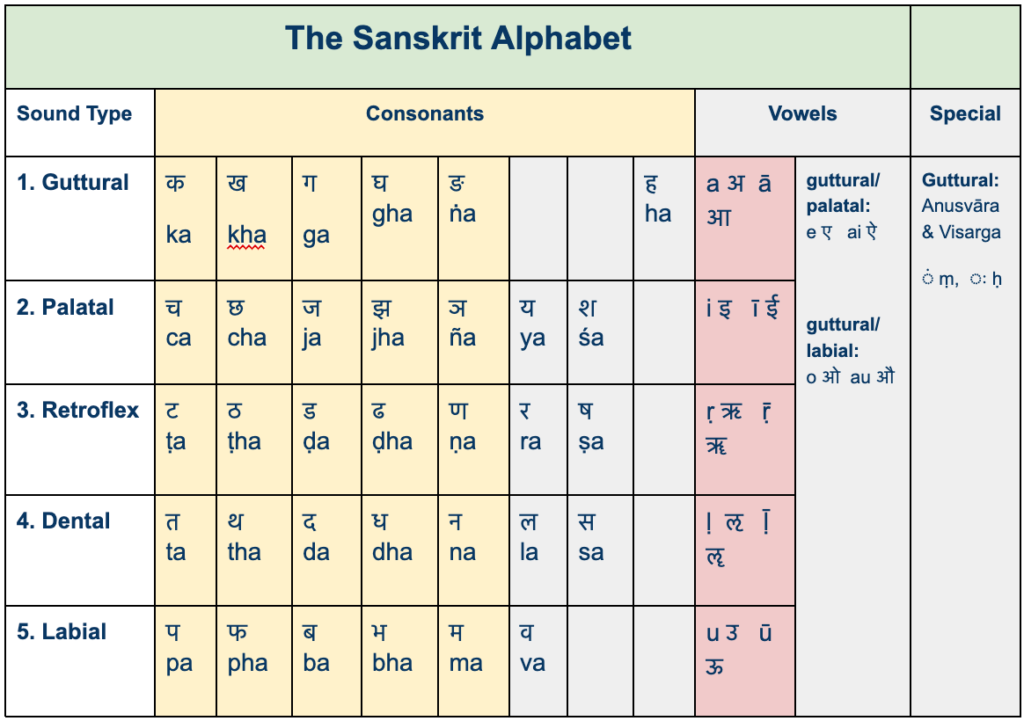
Below is a second table of the alphabet in which the groups of letters associated with each stāna are displayed vertically. This style emphasizes the importance of these points of pronunciation in the mouth. Below the table is an illustration showing the five points of articulation.

1 Guttural, kaṇṭhya
Sounded in the throat at the soft palate with the back of the tongue.
2 Palatal, tālavya
Sounded at the hard palate at the roof of the mouth. The middle of the tongue arches up toward the palate. Palatal sounds are NOT made with the tip of the tongue placed at the ridge behind the teeth as they are in English.
Sounded just above the alveolar ridge at the front roof of the mouth. In the diagram at left, see #5. For the letters in this sthāna, the tongue is pointed upward.
3 Retroflex, mūrdhanya
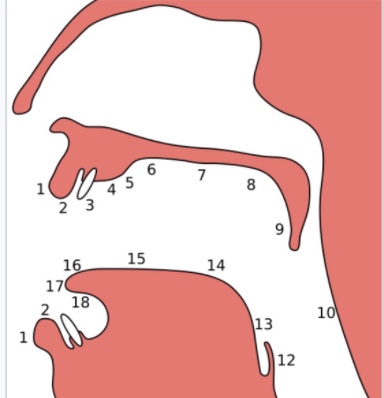
Sounded just above the alveolar ridge at the front roof of the mouth. In the diagram at left, see #5. For the letters in this sthāna, the tongue is pointed upward.
Notes: 1) Some schools of thought place the retroflex position at position #6 in the diagram. 2) Another term for this position is cerebral.
4 Dental, dantya
Sounded at the back of the front teeth. The tongue points forward toward the teeth.
5 Labial, oṣṭhya
Sounded at the lips, with no action by the tongue.
More detail later
The exact mode of pronunciation at these five locations differs for the various groups of akṣaras (vowels, stop letters, semivowels, sibilants, aspirate). We explore those specifics in subsequent lessons. You will find it helpful to relate the numbers, 1-5, with the names of the stānas as you learn these pronunciation points.
Correct articulation is essential
It is vital to use the correct mouth positions and vocal movements for each of the Sanskrit sounds. It is not sufficient to merely approximate them. Gaining such linguistic precision will likely require you to learn new patterns of pronunciation that are not in your native language. But, it is well worth the effort. If you learn to faithfully pronounce each akṣara, you will be able to pronounce any word and, thus, learn to correctly pronounce any mantra, śloka or stotra.
Certain of the five Sanskrit positions are not used in English (and other languages). As such, speakers must work to master these vocal patterns to accurately express the Sanskrit akṣaras that originate from those positions.

Points of articulation
Sanskrit uses five specific points of articulation. The importance of learning these accurately, through practice and careful listening, can be appreciated by understanding that these five constitute just a fraction of the points used in humanity’s many languages. The illustration at right from Wikipedia lists 18 points of articulation: 1) Exo-labial, 2) Endo-labial, 3) Dental, 4) Alveolar, 5) Post-alveolar, 6) Pre-palatal, 7) Palatal, 8) Velar, 9) Uvular, 10) Pharyngeal, 11) Glottal, 12) Epiglottal, 13) Radical, 14) Postero-dorsal, 15) Antero-dorsal, 16) Laminal, 17) Apical, 18) Sub-apical.
Supplementary Video: The Sounds of Sanskrit
Professor Anuradha Chaudry presents the varṇamālā and the five points of articulation.
Lesson 4: Introducing the Vowels
Vowels are called svarāḥ. Vowels are unique in that they can be pronounced independently, without the accompaniment of other letters. In pronouncing vowels, the sound is free-flowing and unrestricted.
In contrast, consonants, vyañjana, need the help of a vowel to be uttered. They cannot be expressed in their fullness without a vowel.
In the following table, we present the Sanskrit vowels in Devanāgarī and Roman script. Take careful note of their points of articulation in the mouth, as indicated in the bottom row: guttural, palatal, retroflex, dental and labial.
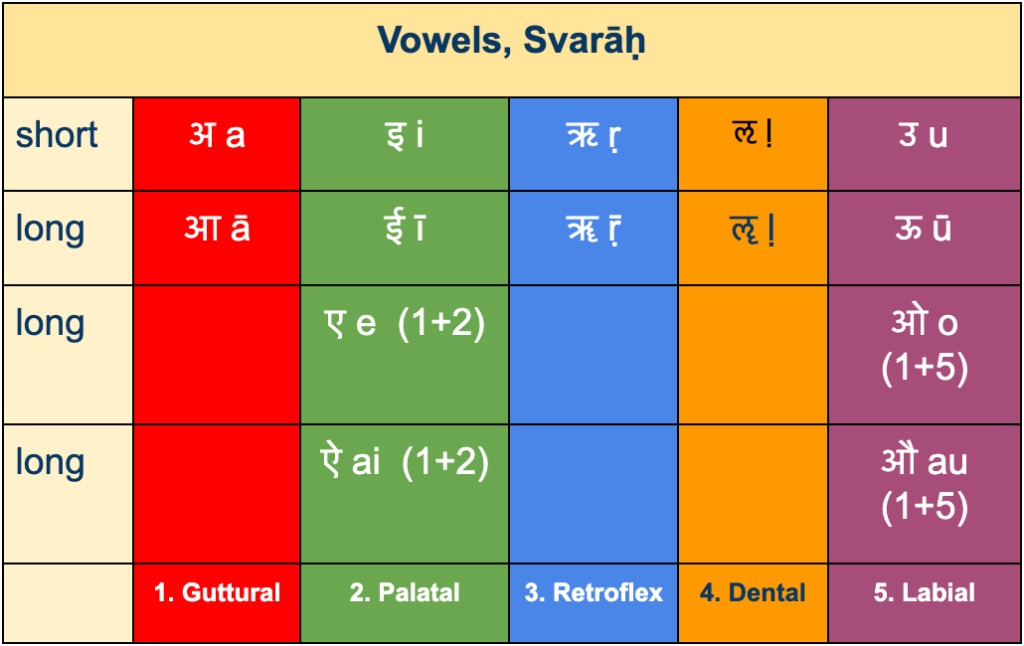
Lesson 5: Simple Vowels
Among the 14 Sanskrit vowels, the first five are the most basic:
a अ
i इ
u उ
ṛ ऋ
ḷ ऌ
Each of these five vowels has a short (hrasva) and a long (dhīrga) version:
ā आ
ī ई
ū ऊ
ṝ ॠ
ḹ ॡ
Hrasva and dhīrga are the Sanskrit terms for short and long duration. Long simple vowels are distinguished in transliteration by a horizontal line above the letter, like this: ā. Long vowels are sounded for two beats. Short vowels (hrasva, svara) are sounded for one beat. A beat is known as matra in Sanskrit. The length of each beat, or matra, depends on the speed of recitation or speech.
These ten letters are called simple vowels or samānākṣara—homogeneous letters—meaning they carry a uniform sound throughout. Śuddha svaraḥ, or pure vowels, is another term for these fundamental letters.
Pluta Vowels
There is a third vowel length called pluta, which is found, though not commonly, in the ancient Vedic texts. Pluta vowels are given three matras. They are generally indicated by a Sanskrit number three (३) in Devanāgarī (usually following after a dīrgha marked vowel), for example आ३. They are similarly marked in transliteration. Thus आ३ is transliterated ā3. Alternatively, some texts mark pluta vowels simply with a 3, leaving off the long vowel mark, using this format: अ३ and a3. Pāṇini compares the three counts to the call of a rooster. The presence of pluta vowels in Vedic texts is one of many differences between Vedic Sanskrit in the more modern Classical Sanskrit. These differences come strongly into play in chanting. They also become relevant when looking up words in Sanskrit dictionaries. For example, in Vedic Sanskrit, ḍa and ḍha may become ḷa and ḷha. This can be found in the first line of the Ṛg Veda, where agnim iḍe is found as agnim iḷe. While the pronunciation is ostensibly the same, iḍe can be found in the dictionary while iḷe may not.
A Vowel Rarely Used
Occurrences of the vowel ḷ ऌ are extremely rare, perhaps occurring in only one Sanskrit verb root: kḷp. Moreover, the long version of this vowel ( ḹ ॡ ) is not known to occur in any words. For this reason, some presentations of the alphabet list the vowel ḷ ऌ as having no long version. This is correct in the sense of Sanskrit as a spoken language only. But, it is not correct if we recognize Sanskrit as a set of esoteric/spiritual vibrations or sounds that transcend their usage in words. This metaphysical perspective is reflected in the placement of the letters as seed syllables (bijas) on the petals of the cakras, where ḹ ॡ occurs in the viśuddha cakra, filling out the list of ten vowels.
Exercise 1.5.0: A pronunciation guide
On your own, practice approximating the simple vowel sounds from English words. Repeat the word and then the vowel.
a अ is pronounced like the u in but or the a in about
ā आ is pronounced like the a in father
i इ is pronounced like the e in recall
ī ई is pronounced like the ee in succeed
u उ is pronounced like the u in put
ū ऊ is pronounced like the oo in pool
ṛ ऋ is pronounced like the ri in rig
ṝ ॠ is pronounced like the ree in reed
ḷ ऌ is pronounced like the lry in “jewelry”
ḹ ॡ is pronounced same as previous but long
Exercise 1.5.1: Learning the simple vowels
Follow along with the audio as the narrator repeats the simple vowel sounds. Listen closely to his pronunciation.
Supplementary Video: Mastery of Sound
“The First Sanskrit Lesson—Mastery of Sound,” stresses learning the alphabet well and provides a lucid presentation of the vowels.
Lesson 6: The Vowel Ṛ
The vowel ṛ ऋ can seem challenging to English speakers, but is actually not so difficult. It is pronounced, according to tradition, in two primary ways. Purely speaking, it is simply an r sound, and is pronounced as such. Often, however, it is colored by a short, subtle i or u—generating the hint of ri or as ru—usually while rolling the r at least slightly.
InDepth: Background on ṛ
The vowel ṛ is believed to have originally been pronounced simply as r (like the re in acre), though the use of this pronunciation is rare today. The original character of this pronunciation is easily gleaned by saṃskṛta treatment of the letter. Take for example mahā + ṛṣi, the resulting sandhi will be maharṣi (the vowel ṛ becomes a regular r). The pronunciations of Maha Riṣi, or Maha Ruṣi, sound quite different from the resulting Mahaṛṣi (the spelling that results when Mahā and Ṛiśi join). Yet Maha Ṛṣi (pronouncing the re of acre for ṛ) sounds very similar to the resulting Mahaṛṣi.
Exercise 1.6.1: The letter ṛ
While listening to the audio, repeat each word after it is spoken by the teacher.
amṛta
smṛti
garbhagṛha
sṛṣṭi
ṛṣi
vṛtti
While listening to the next audio, in this part of the exercise, recite the words in each column, the first group starting with ṛ, the second with ṛ within a word, and the third group ending in ṛ.
Next, following the audio, recite the words across the rows instead of top to bottom.
Following
ṛta
ṛṣi
ṛddhi
ṛju
ṛgveda
ṛti
ṛhat
Beginning
tṛta
dṛṣṭi
vṛddhi
sṛjati
mṛga
smṛti
gṛha
Ending
kartṛ
sṛ
boddhṛ
pratijṛ
samṛ
smṛ
āhṛ
Lesson 7: Diphthong Vowels

The final four vowels—e ए, ai ऐ, o ओ, au औ—are diphthongs (column 3 above). Each is a blend of two other vowels.
In contrast to simple vowels, which are samānākṣara or homogeneous letters, these akṣaras are non-homogenous letters (sandhyākṣara), meaning they do not maintain the same sound throughout pronunciation. They are also known as saṁyukta svaraḥ, meaning conjoined vowels.
e ए is a combination of: a अ + i इ
The diphthong e is a combination of a and i. It begins with the sound a (guttural) and directly closes to the sound i (palatal), forming the akṣara e. It is started at position 1, guttural, and moves to position 2, palatal.
Note: The movement between these two positions for this diphthong is so swift and natural that chanters generally treat it as a simple palatal sound (position 2), without consciously trying to include the momentary originating sound a; that occurs automatically.

ai ए is a combination of: a अ + e ए
The diphthong ai is a combination of the two vowels a and e. It begins with the sound a (guttural) and gradually closes to the sound i (palatal), forming the akṣara e.

o ओ is a combination of: a अ + u उ
This diphthong o is a combination of a and u. It begins with the sound a (guttural) and directly closes to the sound u (labial), forming the akṣara o. As with the diphthong e, movement between these two positions for this diphthong is so swift and natural that chanters generally treat it as a simple labial sound, without consciously endeavoring to include the momentary originating sound a. That occurs automatically.
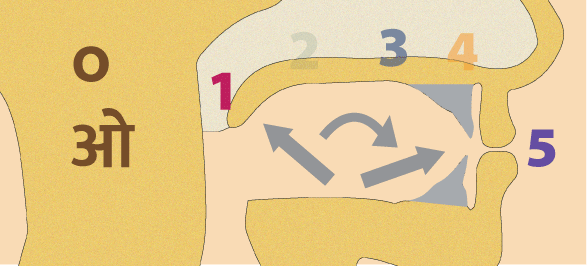
au औ is a combination of: a अ + o ओ
The diphthong au is a combination of a and o. It begins with the sound a (guttural) and gradually closes to the sound o (labial), forming the akṣara au.
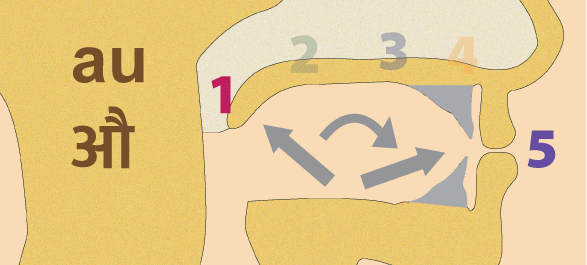
Pronouncing e / ए and o / ओ as unitive sounds
As explained above, it is important to note that the two simpler diphthongs, e and o, are almost universally pronounced as unitary sounds by modern chanters. In fact, it is uncommon for e and o to carry their true diphthong character. While we recognize their genuine dual nature linguistically (as demonstrated by their treatment in the rules of sandhi, etc.), in practice, e and o are pronounced as unitary sounds. The letter e is palatal (position 2), and o is guttural (position 1).
Reminder: The four diphthong vowels are always long (two beats), even though they are not marked with a horizontal line.
Exercise 1.7.0: Diphthongs in English words
On your own, practice repeating aloud the English words below, as you would in normal speech, noting the point where the sound occurs that matches the Sanskrit letters. This is an exercise in approximating the diphthong vowel sounds from English words. Alternately repeat the word and then the vowel.
As you will see in this and other exercises, saying common English words and isolating the sounds in them is a good way to learn the Sanskrit akṣaras. Not all Sanskrit letters have perfect English matches, and some vary by dialect spoken, but the examples will still help with understanding and approaching the sounds.
e ए —— like the a in gate or the e in prey
ai ऐ —— like the I in I’m or the ai in aisle
o ओ —— like the o in wrote and stone
au औ —— like the ou in loud or like the ow in cow
Exercise 1.7.1: Learning the diphthong vowels
Follow along with the audio as the narrator repeats the diphthong vowel sounds.
Listen closely to the pronunciation.
Exercise 7.2: Study the four diphthongs
Start by focusing on the vowels ai and au. Pronounce separately the two sounds which make up the sandhyaksharas, and then the sandhyaksharas themselves. Take time to notice the similarity and differences between the sounds. When the sounds are connected together, the sliding of the tongue from one vowel sound to another creates a transition sound which is not present when a full pause is left between the letters:
a – i = ai
a – u = au
Now study the letters e and o with their components sounds. Go slowly and try to notice the differences between the sounds.
a – i = e
a – u = o
Lesson 8: Vowel Duration & Syllable Duration

As we discussed earlier, the first five vowels (a, i, u, ṛ, ḷ) have both a short and a long version, as shown in the table above.
Short (hrasva) vowels have a duration of one beat, or mātra. Long (dīrgha) vowels have a duration of two mātras. Diphthong vowels (e, ai, o, and au) are long by nature. The duration of a long vowel is twice that of a short vowel.
In Roman transliteration, long vowels are indicated by a horizontal line above the letter. The diphthongs (e, ai, o, and au) are not marked, even though they are held for two mātras. This is something one must press upon one’s mind—so as to always sound these akṣaras for two mātras.
Heavy and Light Syllables
In addition to long and short vowels, there are also two types of syllables: heavy (guru) and light (laghu). Heaviness/lightness also refers to duration.
Heavy (long) syllables take two mātras to pronounce. Light (short) syllables take one mātra to pronounce. There are no markings to indicate whether a syllable is heavy or light. But this becomes evident once the governing principles have been absorbed.
We will discuss guru/laghu later in detail, but keep it in mind and take note as you listen to the teacher chanting the words in the exercises before we get to the lessons on syllables. The main point to remember now is that having a long vowel is only one of the factors that makes a syllable long.
Exercise 1.8.1: Heavy and Light Syllables
Following along with the audio, repeat each word in the list below after it is spoken by the teacher.
kāla — kalā — kāma — karma — kathā — kāya
mala — mālā — maya — māyā — mudrā — advaita
nāda — nandi — nāḍī — nāga — nātha — namaḥ
gautama — mūla — mokṣa — veda
bhava — bhuta — deva — bhoga — vīra
